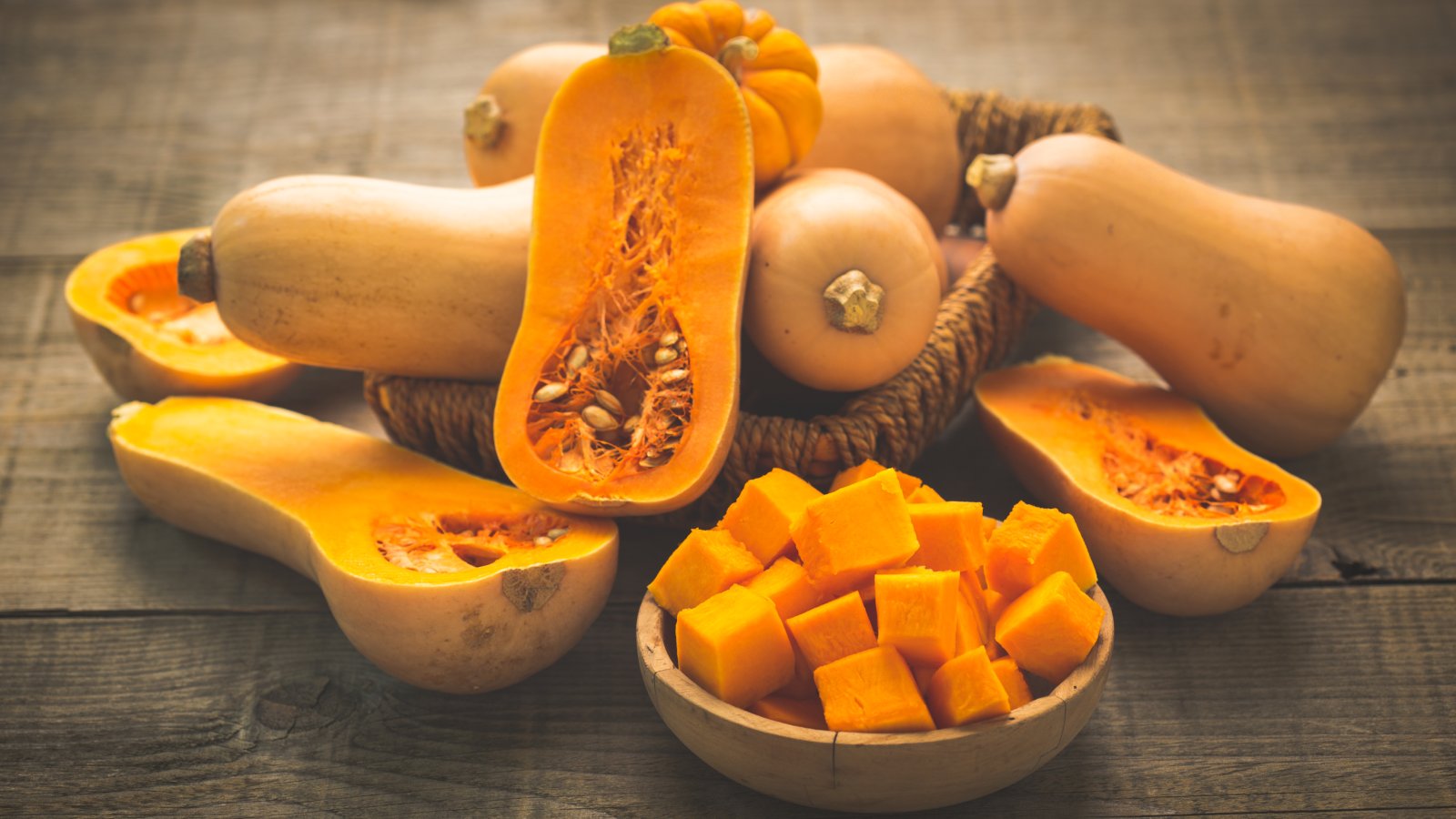How To Grow Butternut Squash Plants
Growing a butternut squash plant makes a tasty and prolific addition to the garden. Learn how to plant, grow and harvest this nutritious vegetable.

Quick Facts:
Botanical name: Cucurbita moschata
Height: Up to 18 inches (46 cm)
Spread: 5-15 feet (1.5-4.5 m)
Sun exposure: Full sun
Soil requirements: Rich, well-draining
Hardiness zones: 2-11
When to plant: May to June
Butternut squash plants are a type of winter squash. Unlike summer squashes, it is eaten after it reaches the mature fruit stage when the rind has become thick and hardened. It’s a great source of complex carbohydrates and fiber as well as being high in potassium, niacin, beta carotene and iron. It stores well without refrigeration or canning and each vine will yield from 10 to 20 squash if properly maintained.
The fruit of the butternut squash plant has a sweet, almost nutty flavor that can be used with a variety of cooking methods. Its versatility combined with its long shelf life, make growing butternut squash a popular crop in the home garden. If you’re intrigued by this winter squash you’ll want to know when and how to plant butternut squash. Read on to learn how to grow butternut squash from seeds.
What is a Butternut Squash?
Butternuts are a tasty winter squash that can be baked, stewed, stuffed, grilled, roasted or mashed. Winter squashes have a hard exterior shell and a much longer storage period than thin skinned summer squash.
Butternut (Cucurbita moschata) is derived from one of the four New World species of squash that have been cultivated for at least 6000 years. It was being grown in the New World by the time Europeans came to explore in the 16th century but wasn’t brought to market until the 1940s when a Massachusetts grower fine-tuned this variety on his farm.
How to Grow Butternut Squash
To start butternut squash indoors, you’ll need to plant seeds about six weeks before the last frost in your area. Plant them in good soil in a sunny window or greenhouse and transplant to the garden after all danger of frost is past. Seeds can also be directly sown outside in well-draining soil. in late May to early June when all danger of frost is past and the soil is well warmed by the sun to about 60 to 65 degrees F. (15-18 C.) Plant seedlings at a 4-inch (10 cm) depth. Butternut squash plants are extremely tender. The seedlings will freeze with the slightest frost, and seeds will only germinate in warm soil.
Butternut squash cultivation takes up a great deal of space in the home garden. Like most other vining vegetables, cultivation of this squash begins with creating a hill. Draw your garden soil into a hill about 18 inches (46 cm) high. This allows the soil to heat around the seeds and roots. Each hill should have at least fifty square feet for growing. Butternut squash seeds can send out vines up to 15 feet (4.5 m) long.
Plant 3-4 seeds per hill in full sun that are 24-36 inches (61-91 cm) apart in rows that are 5-6 feet (1.5-1.8 m) apart. and cover them with enough soil to conceal them. Keep the seeds moist and the surrounding area weed free.
Sign up for the Gardening Know How newsletter today and receive a free copy of our e-book "How to Grow Delicious Tomatoes".
As described below, soil should be well amended and well fertilized. Keep the soil moist, but not soggy. In about 10 days, the seeds will sprout. When they’re about 6 inches (15 cm.) high, thin out the weakest plants, leaving three plants per hill.
Once the plants have their first set of true leaves, thin each hill to the two strongest plants.
Water and Light Requirements
The butternut squash growing season is about 110-120 days for fruit maturation, so if your season is short, it’s best to start your seeds indoors to give them a head start.
When they’re ready to transplant, gradually harden off the seedlings over the course of a week, then transplant them into an area of full sun. Continue to keep the area weed free, providing the plants with an inch (2.5 cm) per week of water. The soil should be moistened down to 8-10 inches (20-25 cm) deep. Mulch around the plants to retain moisture and slow weeds.
Soil and Fertilizer Needs
Butternut squash thrives in well-draining soil that is rich in compost. These plants are heavy feeders and will need supplemental fertilizer during the growing season. Fertilize plants with compost tea or a liquid fertilizer every 2-3 weeks. Plants can be side dressed with compost or aged manure midway through the growing season. Cultivation should be done by hand or with a hoe. Don’t cultivate too deeply since the squashes’ roots are shallow.
Problems, Pests, and Disease
Aphids, beetles, slugs, spider mites, squash bugs, stem borers and slugs may all assault butternut squash. Watch carefully for bugs and when the need arises, use insecticidal soap. Apply insecticides in the evening when bees have returned to their hives, since bees are essential to successfully growing butternut squash.
Several viruses are known to affect this winter squash, such as squash mosaic virus and cucumber mosaic virus. Other diseases that affect squash include powdery mildew, downy mildew, scab, and wilt.
Other problems related to growing butternut squash have to do with the sheer size of the vines. Vines can be pruned to retard their size and allow the plant to focus energy on just three or four plants, or there are smaller cultivars available for those lacking space.
How to Harvest and Store Butternut
Butternut squash is ready to harvest when the color has deepened and is a dull gold without any green streaking. An indicator of readiness is gently pressing a fingernail into the skin. If it leaves no mark, the fruit is ready.
Be sure to harvest butternut squash prior to a hard frost. Cut the fruit from the vine with a sharp knife, and allow the squash to cure in a warm, dry area for a week or two prior to storing. Store in a cool, dark area of about 50 F (10 C) for up to three months.
Best Butternut Squash Varieties
The Waltham cultivar is one of the most popular butternut squashes. An heirloom and likely one of the most commonly grown butternut today, Waltham is a large squash averaging 4-5 pound (1.8-2 kilo) fruit that keeps for several months. Atlas is another butternut that has larger fruit than Waltham, although it yields more fruit per square foot.
Some smaller options are Butterbaby Little Dipper, and Butterscotch. The fruits on these smaller vined cultivars weigh about 1-2 pounds.

Jackie Rhoades began writing for Gardening Know How in 2010.

